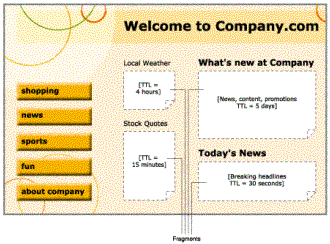| When jesi_template.jsp
executes, the application server uses the JESI custom tag library
to convert JESI tags to ESI tags before returning the ESI-encoded
HTML output to Web Cache. Web Cache then processes the ESI markup
in the HTML page and fetches the fragment, jesi_fragment.jsp,
from the application server. The fragment content can be seen
in the khaki-colored box at the top right. After retrieving
the fragment, Web Cache sends the fully assembled HTML page (stripped
of ESI tags) to the browser.
The template page is cached and expires a minute later. The fragment
content is not cached and is refreshed each time the
page is requested. By clicking the Reload or Refresh button in
your browser, you can witness the caching policies in action.
While the timestamp for the fragment changes with each reload,
the timestamp for the template changes only once every minute.

Example ESI template page containing ESI fragments
and their expiration policies (TTL, or time-to-live)
The use of ESI and page fragment caching as demonstrated
on this page
allows you to build highly scalable Web applications while serving
customized content to your users.
|



